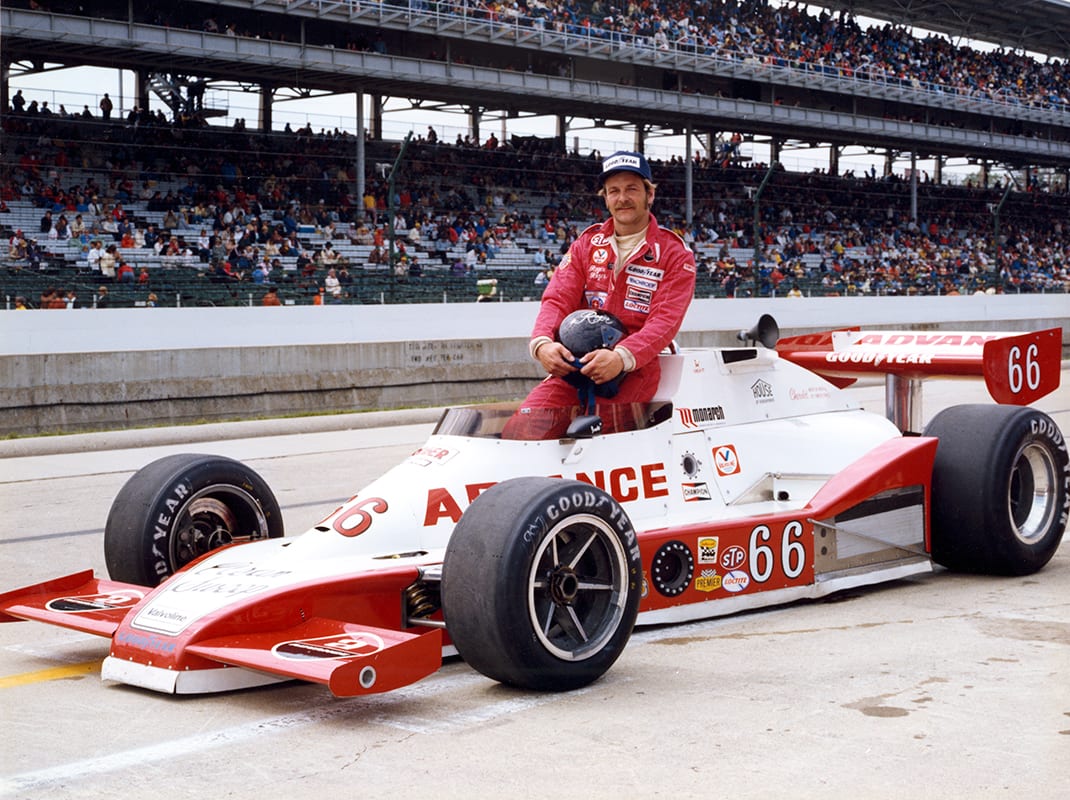Roger Rager, born in the sprint car racing hotbed of Lincoln, Neb., fittingly won his first race in a sprint car at Lincoln’s Jefferson County Speedway.
Rager erupted out of Lincoln to win sprint car races across the country. He led the 1973 American Sprint Car team that competed in South Africa and claimed the Knoxville (Iowa) Raceway track championship the following year.
Fellow sprint car racer Lee Kunzman recalls Rager as, “… a lot of fun, if a bit wild, off the track. But a solid racer you could run hard with.”
Despite Kunzman’s characterization, Rager wasn’t above extending his fun side to the track.
“Once, I did a live race play-by-play from my sprint car at North Star Speedway,” Rager recalled. “Minneapolis radio station WDGY miked my helmet and I gave commentary like, ‘OK, this guy is running high. I’ll get under him in a couple laps. Things like that.”’
Rager won the feature while broadcasting.
In 1978, Rager decided he should take on the Indianapolis 500. Since Indy car owners weren’t exactly clamoring for sprint car drivers, he settled for a low-budget operation. While quick in questionable equipment, he crashed attempting to qualify.
USAC loosened its rulebook to encourage the use of stock-block engines in 1979. That caught Rager’s attention. Two stock-block-powered cars made the race. Rager didn’t.
That year some teams cheated the turbo boost pressure restrictions. With his normally aspirated car, Rager couldn’t if he’d wanted. To assuage the controversy, 35 cars started the race, but Rager was 36th fastest in his ancient 1968 Eagle/Chevy.
Determined to make the 1980 field, Rager started with a budget of only $55,000, $45,000 of which went for a three-year-old Wildcat. For power, Rager chose an engine that secured his place in Indianapolis lore — a junkyard Chevy school bus engine.
There was some genius to his perceived madness, however. The block being a race engine’s foundation, he wanted a well “seasoned” one.
Recalled Rager, “My theory was if I got a block out of a truck or a heavy unit, the numerous heat cycles under load would’ve eliminated the stresses that cause failure. At the junkyard, I spotted a Chevrolet bus that I thought would be ideal.”
He then petitioned expert mechanics for their advice.
“I called NASCAR and got the phone numbers of their 10 top mechanics,” explained Rager. “I asked each what cams they used, pistons, rods, all that, and compiled a list. The most recommended items were what I used.”
With his school bus engine, Rager thrilled followers when he qualified 10th quick, ahead of A.J. Foyt, Tom Sneva and Gordon Johncock.
“When the race started, I had Foyt on the outside of my row,” recalled Rager. “So I thought I’d follow him. But he actually slowed me down.”
Rager got around the legendry Texan and charged to the lead.
Rager’s Cinderella story ended on lap 56 when Jim McElreath spun in front of him. “I had Johncock and Sneva on my right rear, so I pushed low to miss McElreath, who I was lapping for the fifth time. One wheel hit the grass and away I went,” sighed Rager.
Rager attempted the 500 a couple more times but came up short. He left racing to develop his Loon Lake resort in Minnesota. In 1998 came an unexpected call.
“This guy wanted me to drive his sprint car and wouldn’t take no for an answer,” said Rager.
He planned only a one-off jaunt at Wisconsin’s Cedar Lake Speedway. But he finished second in the feature and thought, “Damn! If it’s this easy, maybe I should start driving again.”
At age 50, he did — for another 10 years. He won another 30 features and became the only driver to win at Knoxville Raceway in five decades.
“I had kids whose dads I’d raced against,” laughed Rager, “asking me when I was going to quit so they could win. I told them, ‘If you can’t beat an old man, maybe you don’t need to be racing.’”
Rager retired in 2009.
He’s been inducted into the National Sprint Car Hall of Fame, the Nebraska Sports Hall of Fame, the Knoxville Raceway Hall of Fame and the BCRA Hall of Fame.
